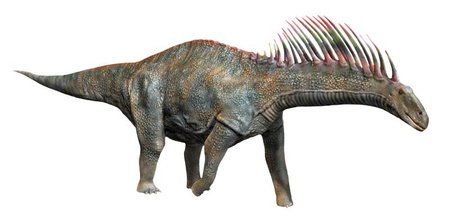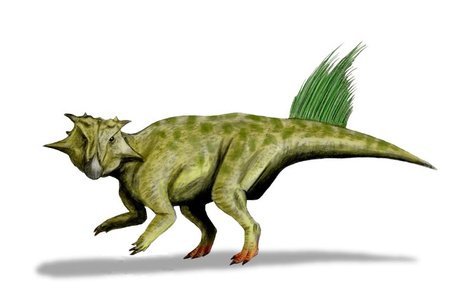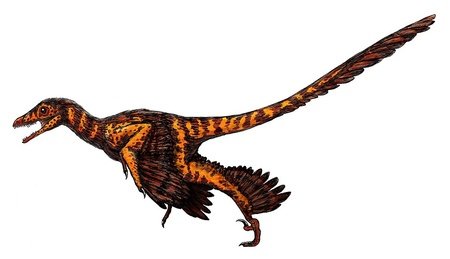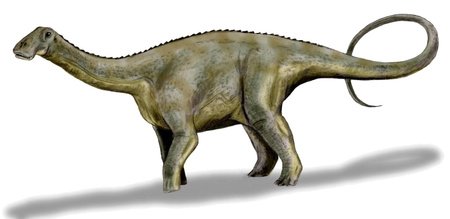
Analyzing Some Dinos (read everything before you get confused)
First published: Friday May 28th, 2021
Report this blog
b E f o r E A n Y o n E g E T s C o n F U s e D
I just managed to whip this one up from right after my Q&A to now. If you haven't already, please read the blurb, because I was sorta in a hurry and I want to make a fun blog before I go for a bit. Although I can't shut myself up about break, I may be able to squeeze in at least one blog.
This blog is going to go into F I V E dinosaurs that you guys may or may not have heard of, including a sauropod, or long-necked dinosaur, that could potentially have had a "skin sail" like a Spinosaurus!
Amargasaurus

Kingdom: Animalia
Phylum: Chordata
Order: Saurischia
Family: Dicraeosauridae
Genus: Amargasaurus
Species: A. cazaui
Scientific Name: Amargasaurus cazaui
The Amargasaurus and is a genus of sauropod dinosaur from the Early Cretaceous, from what is now Argentina. It was first described in 1991, being a large animal but small for a sauropod. It reached up to 33 feet in length, but most distinctively, it has two parallel rows of tall spines down its neck and back. It could be for display, defense, combat, and could even have supported a skin sail!
The Amargasaurus was discovered in sedementary rocks of the La Amarga formation. It also shared its environment with some other sauropod species, according to the level on the sedementary rock.
This dinosaur was small for its size, being in the family of Dicraeosauridae, consisting of sauropods with shorter necks and smaller bodies. They stretched as long as 30-33 feet in length and weighed about 2.9 tons. It looked similar to most sauropods, with a long neck and tail, small head, and a barrel-shaped torso supported by four column-like legs, the front ones bring shorter than the back.
The Amargasaurus has a complex family tree, just like other sauropods, theropods, etc. Amargasaurus emerged last, after its so-called, "siblings," the Brachytrachelopan and the Dicraeosaurus.
One Random Fact: Some people believe Amargasaurus used its spikes to make a loud, threatening noise by shaking their neck to make the spikes clash.
Whatever you do, do not think this thing is a friggin Argentinosaurus.
Thank you.
Linhenykus

Kingdom: Animalia
Phylum: Chordata
Order: Theropoda
Family: Alvarezsauridae
Genus: Linhenykus
Species: L. monodactylus
Scientific Name: Linhenykus monodactylus
The Linhenykus is a extinct genus of alvarezsaurid theropod dinosaur from the Late Cretaceous of Inner Mongolia. It is the most basal known member of the Parvicursorinae. This genus gets the name from Linhe, a city near the site where this dinosaur's fossil was found.
This genus was small-bodied, only a few feet in length, and having a 2.8-inch-long femur, which is the longest bone in the human body. These dinosaurs have really short forelimbs, each with a single greatly enlarged digit. It is the first known alvarezsaurid to have only a single, second digit. Although a third metacarpal is present, the phalanges of the third digit was entirely lost.
The fossil of this small dinosaur was collected in Inner Mongolia, China, from the Late Cretaceous Wulansuhai Formation of Nei Mongol, China. Linhenykus is currently known from a partial skeleton, holotype IVPP V17608, including cervical, dorsal, sacral, caudal vertebrae, forelimb, hindlimbs, and pelvis.
One Random Fact: Only two species of this genus have been found by paleontologists.
Don't mix this up with a Compsognathus or any other alvarezsaurid dinosaurs.
Psittacosaurus

Phylum: Chordata
Order: Ornithischia
Family: Psittacosauridae
Genus: Psittacosaurus
Species: P. sibiricus
Scientific Name: Psittacosaurus sibiricus
The Psittacosaurus is a genus of ceratopsian dinosaur from the Early Cretaceous of what is now Asia. It is notable for being the most species-rich dinosaur genus, up to 12 species known across China, Mongolia, Russia, and maybe in Thailand and Laos. One Psittacosaurus individual was found preserved with long filaments on the tail, similar to those of Tianyulong.
Psittacosaurus was one of the earliest ceratopsians, but closer to Triceratops than Yinlong. Once in its own family, other genera like Hongshanosaurus, it is now considered to be a senior synonym of the latter and an early offshoot off the branch that led to more derived forms. The genera closely related to Psittacosaurus are all from Asia, with the exception of Aquilops from North America.
Psittacosaurus vary in size and specific features of the skeleton, but share the overall same body shape with all the species. The best known species of Psittacosaurus could reach up to 2 meters in length, adults weighing around 44.1 lbs. The skull of this genus is highly modified compared to other Ornithischian dinosaurs, extremely tall in height and short in length, almost having a round profile in some species. The portion of the front orbit (eye socket) is only 40% of the skull length, shorter than any other known Ornithischian. The lower jaws of this genus are characterized by a bulbous verticle ridge down the center of each tooth. Both upper and lower jaws sport a pronounced beak, formed from the rostral and predentary bones. The bony core of the dinosaur's beak may have been sheathed in keratin to provide a sharp cutting surface for cropping plant material. As a generic name suggests, the shortt skull and break superficially resembe those of modern parrots.
One Random Fact: This genus's name means "Parrot lizard."
Don't get them confused with yinlongs.
Sinornithosaurus

Phylum: Chordata
Order: Saurischia
Family: Dromaeosauridae
Genus: Sinornithosaurus
Species: S. millenii
Scientific Name: Sinornithosaurus millenii
Sinornithosaurus is a genus of feather Dromaesuarid dinosaur from the early Cretaceous of the Yixian Formation in what is now China. It was the fifth non-avian feather genus discovered by 1999. The original specimen was collected from the Sihuten locality of western Liaoning. It was found in the Jianshangou beds of the Yixian Formation, dated to 124.5 mya. Additional specimens have been found in the younger Dawangzhangzi bed, dating to aroud 122 mya.
Sinornithosaurus is among the smallest of the Dromaeosaurids, with a length at about 3 feet, with higher estimates in 2010 at about 3.9 feet and a weight of 6.6 lbs. Specimens of Sinornithosaurus have preserved feather impressions covering its body, forming the wings. The body feathers were generally between 1.1-1.7 in long.
A study in 2010 indicated that Sinornithosaurus may have had feathers that varied in colors, significantly across different regions on the body, based on the analysis of microscopic cell structures preserved in fossils.
One Random Fact: Sinornithosaurus was the first recorded dinosaur to have a venomous bite like Troodon.
Don't get this genus mixed up with any other small, potentially feathered dinosaurs.
Nigersaurus

Kingdom: Animalia
Phylum: Chordata
Order: Saurischia
Family: Rebbachisauridae
Genus: Nigersaurus
Species: N. taqueti
Scientific Name: Nigersaurus taqueti
The Nigersaurus is a genus of Rebbachisaurid sauropod that lived during the mid-Cretaceous period, about 115-105 mya. It was discovered in the Elrhaz Formation in Niger, very self-explanatory.
Like the Amargasaurus, it was small for a sauropod, 30 feet long and had a weight of around 4 tons, comparable to the modern elephant. Its skull was specialized for feeding, with large fenestrae and thin bones, also with a wide muzzle filled with more than 500 teeth. Unlike other Tetrapods, the tooth-bearing bones of its jaws were rotated transversely relative to the rest of the skull, so that all the teeth were located far to the front. Its skeleton was highly pneumatised, but the limbs were robustly built.
Nigersaurus and its closest relatives are grouped in a within the subfamily of Rebbachisaurinae of the family Rebbachisauridae, which is part of the sauropod superfamily Diplodocoidea, Nigersaurus was probably a browser, and fed with its head close to the ground. The region of its brain that detected smell was underdeveloped, although its brain size was comparable to that of other dinosaurs. There has been debate on whether its head was habitually held downwards, or horizontally like other sauropods. It lived in a riparian habitat, feasting on ferns, horsetails, angiosperms, etc.
One Random Fact: Nigersaurus has been called the Mesozoic Cow because of its wide muzzle.
Don't get these guys mixed up with any other Rebbachisaurid.
b y E
Whelp, just wanted to pop a completely random blog into the mix before I go. What was your favorite dinosaur out of these, did you learn anything today? What is your actual favorite dinosaur?
Here's my answers cuz I'm bored, y'all can answer them too:
Sinornithosaurus, Yes, Allosaurus.

a dinosaur that plays Jetpunk
You can find him exclusively on the Balkan Peninsula, though don't let your own eyes fool you. As gentle as he looks, the Clutch-apod is easily threatened by invaders and will charge you if you do not approach with a large amount of caution.
Rising temperatures and deforestation have decreased the population by nearly 30% since 2008, so please respect him. Despite all this, animal trafficers continue to capture him for a whopping $2,000,000 each.
(Edit: Yall are being ceratopsians now xD)